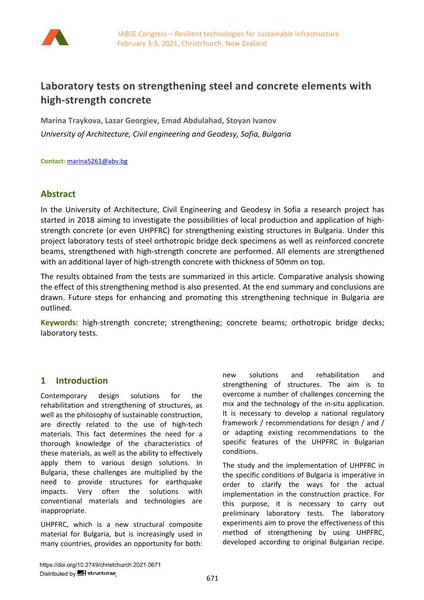Laboratory tests on strengthening steel and concrete elements with high-strength concrete

|
|
|||||||||||
Bibliografische Angaben
| Autor(en): |
Marina Traykova
(University of Architecture, Civil engineering and Geodesy, Sofia, Bulgaria)
Lazar Georgiev (University of Architecture, Civil engineering and Geodesy, Sofia, Bulgaria) Emad Abdulahad (University of Architecture, Civil engineering and Geodesy, Sofia, Bulgaria) Stoyan Ivanov (University of Architecture, Civil engineering and Geodesy, Sofia, Bulgaria) |
||||
|---|---|---|---|---|---|
| Medium: | Tagungsbeitrag | ||||
| Sprache(n): | Englisch | ||||
| Tagung: | IABSE Congress: Resilient technologies for sustainable infrastructure, Christchurch, New Zealand, 3-5 February 2021 | ||||
| Veröffentlicht in: | IABSE Congress Christchurch 2020 | ||||
|
|||||
| Seite(n): | 671-678 | ||||
| Anzahl der Seiten (im PDF): | 8 | ||||
| DOI: | 10.2749/christchurch.2021.0671 | ||||
| Abstrakt: |
In the University of Architecture, Civil Engineering and Geodesy in Sofia a research project has started in 2018 aiming to investigate the possibilities of local production and application of high- strength concrete (or even UHPFRC) for strengthening existing structures in Bulgaria. Under this project laboratory tests of steel orthotropic bridge deck specimens as well as reinforced concrete beams, strengthened with high-strength concrete are performed. All elements are strengthened with an additional layer of high-strength concrete with thickness of 50mm on top. The results obtained from the tests are summarized in this article. Comparative analysis showing the effect of this strengthening method is also presented. At the end summary and conclusions are drawn. Future steps for enhancing and promoting this strengthening technique in Bulgaria are outlined. |
||||
| Stichwörter: |
Verstärkung hochfester Beton
|
||||
